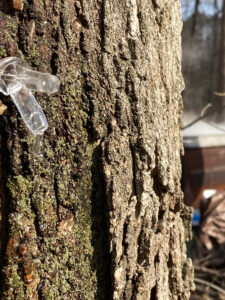By David Fleet
Editor
It’s been more than 40 years since area resident Dale Bond first tapped a few of the stately Brandon Township maple trees. Since then it’s all about the drip.
drip.
“The weather’s been up and down this spring, the sap needs warmer weather and sunlight— but that’s why they call it Michigan,” laughed Bond.
Bond along with neighbors and friends tap about 40 trees each year, gather the sap and boil it down to syrup over a wood fire over a homemade stove on his farm each year.
The local “sappers” make just enough to consume during the year on pancakes or whatever needs a dose of pure Michigan Maple syrup. The laborious process is more about conversations around the stove and basking in the spring weather after a long winter than maple syrup.
The sweet event started back in the 1960s when Bond, a Korean War Veteran and long time area resident attended a local farm auction.
“They had maple syrup production equipment for sale,” he said. “There were metal buckets, spiles and pans to cook along with other items—that’s why I started, I had the equipment.”
Over the years the metal buckets and rusty spiles were replaced with plastic bags and spiles. Similarly, battery powered electric drills replaced a brace and bits to tap the trees–but the wood fire and steaming simmering sap remains in the woods. “It’s very late this year,” said Bond. “It should have been in late February—we need 40 degrees in the day and freezing at night. The first sap is light or prime, then later it gets darker, but the taste is the same.”
While Bond’s Sugar Bush is just for fun, syrup production statewide remains a viable business. Michigan maple syrup farmers hoped for some sweet news for the 2022 season after production dipped in recent years. In 2021 Michigan ranked sixth in syrup producers in the country with 150,000 gallons, down from 170,000 gallons the year before according to the U.S. Department of Agriculture. Vermont out dripped the nation with 2,220,000 gallons, followed by New York 804,000 gallons and Maine third with 590,000 gallons.
Bond says the sap season is about over.“When the trees bud up, we are done for the year,” he said.
